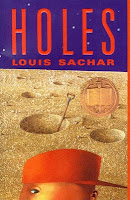But now I'm going to be evil and insert a side note in here before spilling the juice. Oh sure, go ahead and scroll down, I'd do the same thing, but my evil insert is that I am also finally posting my first #WS4U progress report.
Sheri Larsen started the Writers Support For You group MONTHS ago with Tuesday check-ins, but y'all don't want to hear my complicated story of revision burn-out. I have a new project I'm outlining. I will start the first draft of "Seeing Through Dreams" (update: title changed to Star Tripped) in November for NaNoWriMo, but in the meantime, I've been steadily accumulating notes, plot points, character inner conflicts, settings, and worms.
Yup, worms. Not earthworms. Another type altogether. Sort of my own very odd mythical creature invention. I promise they are not slimy.
But anyway, now that I've totally weirded you out, back to my awesome MG discovery.
So I just finished reading Holes, by Louis Sachar. Which I believe every person on the PLANET should read. Because it's just that great. (And, oh, I just realized, Holes kind of goes along with my worms idea. Worm holes.) (Sorry, I'll shut up about the worms now).
Now there are many things about Holes that are great. I could write a whole series of posts on the greatness of this book. But what I am focusing on here is what I also noticed in two other great MG books I've read recently, too:
The Mysterious Benedict Society, by Trenton Lee Stuart.
What do all three great books have in common? The juicy "secret" (sort of) I discovered?
The sneakers in Holes, the peach sploosh, the onions, the yellow-spotted lizards, and even a notebook fished out of a toilet - none of these have anything to do with each other. Until the end.
And it's so cool how all the "plants" add up to a multi-faceted pay-off, like puzzle pieces suddenly fitting together. (Wow, I just outdid myself with that analogy there. Sooooo original.)
The other two books I mentioned also have delicious plant/pay-off treats. And you can't tell, until the end, what is actually a genuine "plant" versus a red-herring.
I'm sure it's not a technique limited to just MG, it's probably been adapted from the mystery genre, but there is definitely a fun MG twist to the plants and pay-off that these three books excel at (you see it a bit in the Harry Potter books, too, but not as fully realized).
I'm curious why I haven't seen this technique in the 68 YA books in my Goodreads "read" list. Yes, there are individual "plants" in YA (Across the Universe, by Beth Revis, is one I can think of right away) but nothing like this smorgasbord of plants that all tie together for a huge pay-off at the end in Holes.
Please share if you've encountered a book (any age range or genre) that has this great plant/pay-off technique! I'd love to find some more to read - they're addictive!






No comments:
Post a Comment